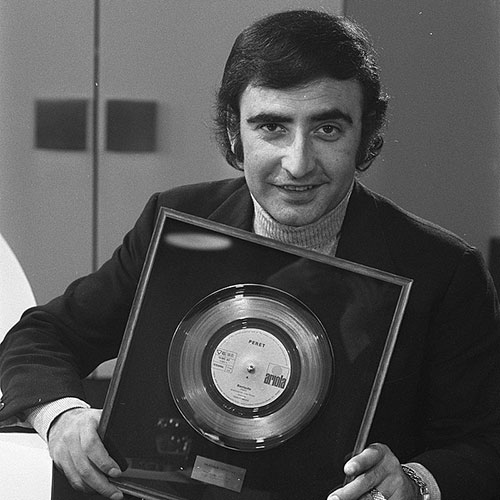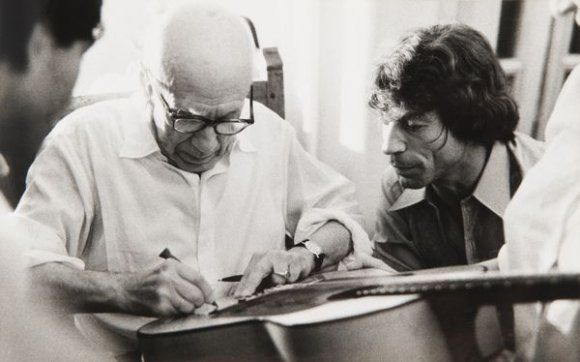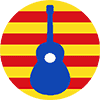History of Rumba Catalana
5. 60s & 70s- Pioneers of Rumba Catalana
Years 60′ 70′ : The Pioneers of Rumba Catalana
Rumba Catalana took off fast, Spanish Catalan Gypsies made it urban and mainstream, French Gypsies kept it closer to the roots of flamenco
The three artists who have made Gypsy rumba popular since its beginnings in Barcelona are Antonio González, a.k.a. El Pescaílla, Pedro Pubill Calaf, a.k.a. Peret, and Josep Maria Valentí “El Chacho” considered the fathers of the genre.
Juan Castellón Jiménez “El Noy”, less known, has also been essential to the history of the rumba Catalana of the 60s. Unjustly forgotten, he was recently rediscovered thanks to a reedition of his songs, until then unavailable.
Festive, easy to approach, easy to dance, the rumba Catalana transcended social divisions and made the whole country sway. From then on there would be an ongoing series of musical hits, until the mid 70s. The golden age of rumba catalana.
The success crossed the borders, Peret’s song “Borriquito“, became a gold record in many countries in 1971.
Being such a craze, generating record sales, the genre soon attracted many artists.

A New Generation of Rumberos is Honing its Skills for the Years to Come
In the footsteps of the pioneers, from the beginning of the 70’s, we find very popular singers and bands like Miguel Vargas Jimenez, alias Bambino, a famous Sevillian singer from Utrera, Lola Flores, wife of El Pescailla, the duo Los Amaya, Dolores Vargas “La Terremoto”, Maruja Garrido, Los Marismeños or the legendary flamenco singer Camaron de la Isla.
The Muñoz sisters of the duo Las Grecas, inspired by the rock of the 1970s, the trio Rumba Tres, and Los Chichos, started their careers in the early seventies and would later become stars of a a very popular genre of rumba, called rumba Taleguera, after the death of Spain’s dictator Franco. Freed from censorship they went on to express the despair of a forgotten youth living in the suburbs, neglected during the following years known as the Democratic Transition, becoming the soundtrack of a social reality and cultural movement known as Quinqui, which still impacts Spanish culture today. More on that later on.
Meanwhile, in France, Rumba Takes Off with Different Flavors, Avoiding the Variety Genre
In France, Ricardo Baliardo, alias Manitas de Plata, (‘little silver hands‘, a nickname from his younger age that he kept all his life) is one of the first to popularize the genre, with the singer José Reyes, his cousin. The latter will create with his sons the group Los Reyes, which will one day become the Gipsy Kings.
A true guitar genius, Manitas, born on August 7, 1921 in Sète, in a caravan, started his career as an international artist at the Carnegie Hall in 1965, filling it for 5 consecutive days. It was his first concert ever. He had previously refused to go on stage, as he wanted to wait for at least ten years after Django Reinhardt‘s death, out of respect.
He never rehearsed, always improvised – a fact that flamenco purists sometimes snubbed. Paco de Lucia, quite the opposite in terms of musical approach, once said to him that if he had been blessed with his talent he could have spared himself years of hard work. The two revered each other.
Listening to an early 1956 recording, one might think he may have been the true precursor of rumba Catalana. The fact is, the right hand technique that made Catalan rumba famous was nothing new, but was adapted by Barcelona musicians to fit with the latino rythms then in fashion.
During his long career – he died in 2014 at the age of 93 – Manitas sold over 93 million albums worldwide.

Unlike with the rumba of the Spanish Gypsies, on the French side the influence of flamenco remained strong, especially in terms of singing. José Reyes, very popular in the Gypsy community in the south of France, was a renowned specialist in cante jondo – the traditional flamenco art of singing. It gave birth to a style of rumba that the world came to know and like years later with the Gipsy Kings.
Gypsy pilgrimage of Saintes Maries de la Mer, in 1968.
IN THE NEXT CHAPTER :
A political earthquake is about to hit Spain, the end of 40 years of dictatorship and the beginning of a new democratic era. Spanish Gypsy bands and traditions won’t fit well with the new ideals of progress, somewhat radical. Catalan Rumba will take a blow.

